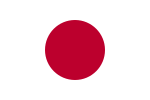| Part of a series on the |
| History of Japan |
|---|
 |
| Part of a series on the |
| Culture of Japan |
|---|
 |
The history of Japan includes the history of the islands of Japan and the Japanese people, spanning the ancient history of the region to the modern history of Japan as a nation state. Following the last ice age, around 12,000 BC, the rich ecosystem of the Japanese archipelago fostered human development. The earliest-known pottery found in Japan belongs to the Jōmon period. The first known written reference to Japan is in the brief information given in Book of Han in the 1st century AD. The main cultural and religious influences came from China.[1]
The current Imperial House emerged in the sixth century and the first permanent imperial capital was founded in 710 at Heijō-kyō (modern Nara), which became a center of Buddhist art, religion and culture. The development of a strong centralized government culminated in the establishment of a new imperial capital at Heian-kyō (modern Kyoto) and the Heian period is considered a golden age of classical Japanese culture. Over the following centuries the power of the reigning emperor and the court nobility gradually declined and the once centralized state became increasingly fractured. By the time of the fifteenth century political power was subdivided into several hundred local units, or so called "domains" controlled by local daimyō, each with his own force of samurai warriors. After a long period of civil war, Tokugawa Ieyasu completed the unification of Japan and was appointed shogun by the emperor in 1603. He distributed the conquered land among his supporters, and set up his "bakufu" (literally "tent office" i.e. military rule) at Edo (modern Tokyo) while the nominal sovereign, the emperor, continued to reside in the old capital of Kyoto. The Edo period was prosperous and peaceful. Japan terminated the Christian missions and cut off almost all contact with the outside world.
In the 1860s the shogunate came to an end, power was returned to the emperor and the Meiji period began. The new national leadership systematically ended feudalism and transformed an isolated, underdeveloped island country, into a world power that closely followed Western models. Democracy was problematic, because Japan's powerful military was semi-independent and overruled—or assassinated—civilians in the 1920s and 1930s. The military invaded Manchuria in 1931 and escalated the conflict to all-out war on China in 1937. Japan controlled the coast and major cities and set up puppet regimes, but was unable to entirely defeat China. Its attack on Pearl Harbor in December 1941 led to war with the United States and its allies. After a series of naval victories by mid-1942, Japan's military forces were overextended and its industrial base was unable to provide the needed ships, armaments, and oil. But even with the navy sunk and the main cities destroyed by U.S. air attacks, the military held out until August 1945 when the twin shock of the atomic bombings of Hiroshima and Nagasaki and the Soviet invasion of Manchuria made it possible for the emperor to force the military to surrender.
The U.S. occupied Japan until 1952. Under the supervision of the U.S. occupation forces a new constitution was drafted and enacted in 1947 that transformed Japan into a parliamentary monarchy. After 1955, Japan enjoyed very high economic growth rates, and became a world economic powerhouse, especially in engineering, automobiles and electronics with a highly developed infrastructure, a very high standard of living and the highest life expectancy in the world. Emperor Shōwa died in 1989 and his son Emperor Akihito ascended the throne marking the beginning of a new era. Since the 1990s economic stagnation has been a major issue, with an earthquake and tsunami in 2011 causing massive economic dislocations and loss of nuclear power.
- ^ Jacques Gernet (1996). A History of Chinese Civilization. Cambridge University Press. p. 290. ISBN 0521497817.
